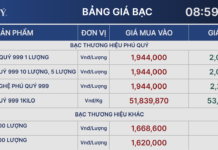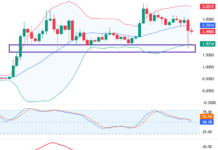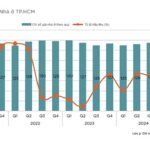At the seminar titled “Vietnam’s Real Estate Market: Identifying Inefficiencies and Solutions” held on the afternoon of October 16, Dr. Can Van Luc, Chief Economist at the Bank for Investment and Development of Vietnam (BIDV), stated that while the market is gradually recovering, numerous risks remain and require cautious management.
According to Dr. Luc, credit investment in real estate has increased by approximately 20% over the past period, while loans for home purchases, factory construction, and production facilities have also seen significant growth. This capital flow has contributed to economic growth but has simultaneously raised the proportion of real estate loans above the general average, posing potential risks if the market reverses.
“In a stable environment, this is manageable, but if interest rates or liquidity change, companies with diversified investments will face significant challenges,” Dr. Luc warned.
He identified five major issues currently facing the market. First, property prices are rising faster than citizens’ incomes. On average, a Vietnamese individual needs more than 26 years of savings to purchase a home, double the global average.

Second, there is a severe supply-demand mismatch, with 63% of projects falling into the high-end segment, while affordable and mid-range projects are in short supply. Third, the tourism and hospitality real estate sector remains struggling, with low absorption rates despite the recovery in international tourism.
Fourth, the application of technology in construction, management, and project development is still weak, leading to higher costs and slower progress. Lastly, input costs have surged, while many companies’ project management capabilities remain limited.
Dr. Can Van Luc also highlighted the widespread practices of hoarding and price manipulation. Speculation rates are high, with 80% of transactions changing hands within a year, compared to three to five years in developed countries.
Regarding policy, he suggested researching a tax roadmap for individuals owning second or third homes to curb speculation, while also considering flexible loan-to-value ratios. Instead of the current tight restrictions, loans of up to 70-80% of the property value could be permitted if valuations are transparent and realistic.
Mr. Le Dinh Chung, a member of the VARS Market Research Task Force, noted that the current housing and real estate market information system is incomplete, inconsistent, and not updated in a timely manner.
Specifically, there is no comprehensive pricing data system. Information on planning and future housing projects eligible for sale is not fully disclosed or easily accessible. Real estate companies have not fully complied with requirements to disclose accurate and truthful project information. Additionally, there is a lack of legal frameworks and specific regulations defining companies’ responsibilities in publishing other relevant information.
He argued that these factors contribute to the real estate market’s lack of transparency, creating loopholes for speculators and driving up housing prices beyond the reach of potential buyers.
Legal Concerns for Buyers: Navigating Property Purchase Risks
When asked about the “biggest risk concerns when buying real estate,” most customers express worries regarding project legality, construction delays, and the project’s liquidity, carefully considering these factors before committing their funds. In contrast, concerns about price fluctuations and rental potential are less prominent.
Da Nang Tightens Land Management, Cracks Down on Price Manipulation and Land Speculation
In response to signs of market manipulation and speculative activities disrupting the real estate sector, Da Nang has mandated a comprehensive review of land management, utilization, and auction processes. This initiative aims to ensure transparency, fairness, and compliance with regulations, safeguarding the market from further distortions.
Hot Real Estate Market Fueled by Proposed New Policies
Amid soaring housing prices and speculative trading disrupting the market, numerous policies have been proposed to lower home prices and stabilize the real estate landscape.











































